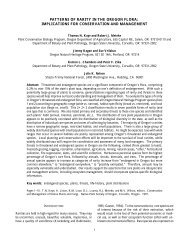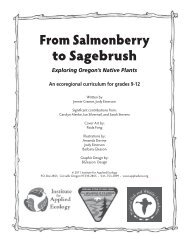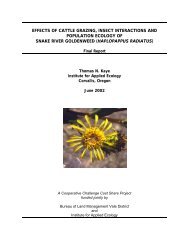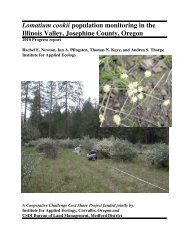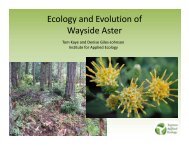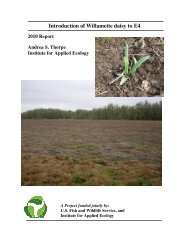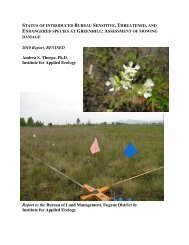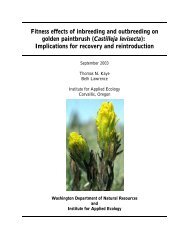Determining appropriate management techniques for Willamette ...
Determining appropriate management techniques for Willamette ...
Determining appropriate management techniques for Willamette ...
You also want an ePaper? Increase the reach of your titles
YUMPU automatically turns print PDFs into web optimized ePapers that Google loves.
ERDE Management Progress Report, 2012<br />
Demography and Management of <strong>Willamette</strong> Daisy (Erigeron decumbens)<br />
Glyphosate (Finley only)<br />
A broad-spectrum herbicide treatment was implemented in late fall at the Finley sites. Because most<br />
native plants are dormant at this time this spray is expected to target mostly non-native species. A 3%<br />
solution of glyphosate (Aquamaster) was applied to selected treatment plots. This treatments is<br />
scheduled to be repeated in 2013 at all Finley sites.<br />
Carbon Addition<br />
In March 2012, we spread 2 kg of carbon m -2 (in the <strong>for</strong>m of sucrose) on selected test plots. Carbon<br />
addition limits the amount of soil nutrients available <strong>for</strong> plant growth (particularly nitrogen and<br />
phosphorus) by stimulating microbial activity. Several studies have indicated that native species are more<br />
capable of tolerating low nutrient conditions than exotic species (Morgan 1994, Reever Morghan and<br />
Seastedt 1999, Alpert and Maron 2000, Blumenthal et al. 2003, Kirkpatrick et al. unpublished data). This<br />
treatment is scheduled to occur at all sites in 2013.<br />
Monitoring<br />
<strong>Willamette</strong> Daisy<br />
Survival and growth of all plants was monitored in June 2011 and June 2012. For each individual, we<br />
measured the widest diameter of a plant (the outermost part of an individual, including flowers), the<br />
diameter perpendicular to the widest diameter, height, and number of capitula (flower heads). The<br />
shape of each plant was assumed to be oval, and the maximum diameter and perpendicular diameter<br />
were used to calculate the elliptical crown cover of each plant as per equation 1.<br />
Equation 1. Elliptical crown cover = (0.5*widest diameter) * (0.5*perpendicular diameter) * π<br />
Community<br />
Ocular estimates of cover of all plant species were per<strong>for</strong>med in each treatment block in June 2012 (at<br />
the time of daisy monitoring). In each treatment square, three 1m 2 plots were measured; at least 54 1m 2<br />
blocks were monitored at each site.<br />
RESULTS<br />
Outplanting Success<br />
In the first year following outplanting survivorship was high at all sites. Survivorship ranged from 92%<br />
at Kirk East to 95% at Field 29 (Table 1). The areal cover of plants varied by site in both 2011 and<br />
2012; plants were larger at the Finley sites than at Fern Ridge and produced more capitula (Table 1,<br />
Figure 7 ). Survivorship from 2012-2013 ranged from 32% to 94%. Overall plants from the Corvallis<br />
West Recovery Zone flowered more often and were larger than their counterparts from the Eugene West<br />
Recovery Zone. In the Eugene West Recovery Zone plants at Kirk East were consistently larger than those<br />
at Applegate (Table 1, Figure 8).<br />
7



